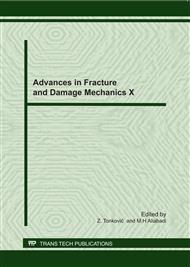p.739
p.743
p.747
p.751
p.755
p.759
p.763
p.767
p.771
A Three Dimensional Graphical Aid for Fatigue Data Analysis
Abstract:
The fatigue behaviour of materials is usually synthesised in terms of stress-life (S-N) curve or in terms of strain-life (e-N) curve, the latter being described by the so-called Manson-Coffin equation. It is known that the assumption of equality of the plastic and elastic components between the Manson-Coffin and the stabilised stress-strain curves leads to the so-called compatibility conditions which connect the equations theoretically. The material constants of the Manson-Coffin and of the stabilised stress-strain curve are commonly determined by best fitting separately the experimental data obtained from strain-controlled fatigue tests. As a consequence the compatibility conditions may not be fulfilled. In this paper a method for fatigue data analysis that ensures the compatibility conditions is proposed and validated against experimental data.
Info:
Periodical:
Pages:
755-758
Citation:
Online since:
September 2011
Authors:
Price:
Сopyright:
© 2012 Trans Tech Publications Ltd. All Rights Reserved
Share:
Citation:


